

Dennis Koble interview
By Scott Stilphen
(2017)
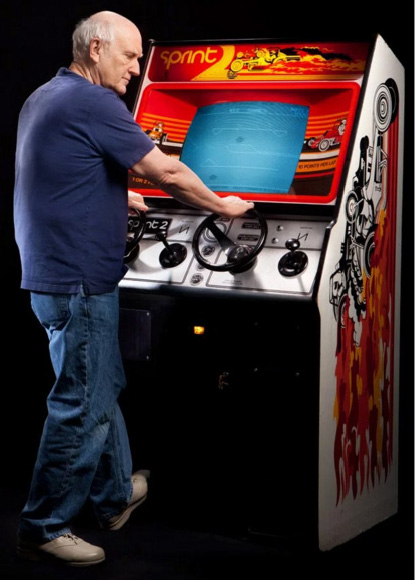
Photograph by Gregg Segal
Dennis Koble started his illustrious career as one of Atari's early coin-op designers. He started at Atari in 1976 and was the 4th programmer hired. During his 5 years there, he worked in nearly every division before leaving to co-found Imagic. He got back into coin-op games with Sente, and later co-founded Polygames, a company that specialized in games for the PC and Sega Genesis. Most recently, he tried his hand at designing mobile app games.
Q: What's your educational background?
Dennis Koble: I graduated from the University of California at Berkeley majored in Electrical Engineering and Computer Science. From there I went to work for Applied Technology Incorporated as a programmer - twice over about a 5-1/2 year period. They mad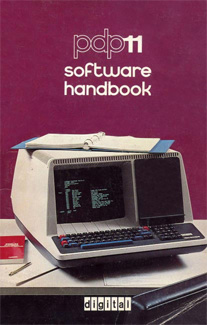 e
defensive military electronics for the U.S. military. I worked there 4 or 5 years. ATI was my very first job and even though I applied for a job there as an Electrical Engineer, I was hired as a programmer (a new department in those days) by the Software group. I did leave for short sojourn to attend the University of Hawaii to work on my Master's degree, but that was aborted over girlfriend problems.
e
defensive military electronics for the U.S. military. I worked there 4 or 5 years. ATI was my very first job and even though I applied for a job there as an Electrical Engineer, I was hired as a programmer (a new department in those days) by the Software group. I did leave for short sojourn to attend the University of Hawaii to work on my Master's degree, but that was aborted over girlfriend problems.
After ATI, I worked for a large software consulting group for awhile at NASA Ames in their research center, working with a researcher who was doing biofeedback. We used PDP-11's (?) to run the software and control the hardware. Right before that, I worked for a short while at a subsidiary of Grid Computing that was making the office software for their new, hot laptop. Then Grid Computing crashed, and I think the order is I went to work for the software consulting company (the name escapes me) at NASA Ames.
Right after that I went to work at Atari. I went to Atari in 1976 as a Senior Programmer in the Coin-Op division, moved over to electronic hand-helds (Ed.: Electronic Toys & Games) for a year or so, and then went back to Consumer and became the Manager of the Consumer division. I was at Atari for about 5 years.
Q: How much of your experience with biofeedback were you able to apply with game design?
Dennis Koble: I'm not sure the biofeedback stuff helped at Atari, but my experience with PDP-11 computers definitely helped. I had only previously worked with small computers and the first microprocessors. The PDP-11 gave me some experience working with larger computers as development tools to help with real-time microprocessor computing. Up to that point, we only had very crude development tools to aid us in programming down in Assembly language.
Q: What or who inspired you to go into game design?
Dennis Koble: I had seen Nolan Bushnellís first game, Computer Space, prior to that and I wondered how Atari made those little spaceships fly around the screen. That way of thinking was totally foreign to me at the time (as it was to probably most programmers). The first game that really inspired me was released just after I joined Atari and that was Breakout, one of my all-time favorites.
Q: How did you hear about Atari?
Dennis Koble: I had a very good friend who was a Manager there at the time by the name of Donald Lang. He invited me over one day and, although I told him I wasnít interested in a job, he said donít worry, just come over and see what weíre doing. The rest is history as they say.
Q: From the bio in your Atari 400/800 Avalanche manual, you were the 4th programmer Atari ever hired.
Dennis Koble: Correct. I do believe Mike Albaugh might have been hired a week or two prior to me.
Q: What was the development process like there?
Dennis Koble: Each game had three team members at the beginning - a hardware engineer, a technician, and a programmer.
There was also input from senior members of the engineering staff like Lyle Rains, who had a very good sense of gameplay and user interface.
Q: Were the titles you worked on assigned, or chosen by yourself?
Dennis Koble: We were assigned titles by the Managers and senior staff.



Atari's Sprint 2, Dominos, and Avalanche arcade games.
Q: Can you discuss each of the games you worked on there? While at Atari, you started in the coin-op department and designed Sprint 2 (1976), Dominos (1977), and Avalanche (1978). From Gaming-History: "Sprint 2 was released in November 1976 and was Atari's first mass-produced microprocessor-based game. Approximately 8, 200 units were produced."
Dennis Koble: This information is correct except I also programmed Sprint 1, and I worked on the first Atari pinball game, The Atarians (1976). I also did a number of consumer games when I went over to consumer, including a series of text-based games for the newly-created Atari Program Exchange (APX). One small correction, though. I received royalties for Sprint 2 while I was in Coin-Op, but I also continued to receive them while I was in the Electronic Hand-helds and Tabletops division (for about a year) and later when I became the Manager of the Consumer division. I may be wrong but I am almost sure that Sprint 2 ultimately sold about 13,000 units during it's lifetime.
Q: In my interview with Howard Delman, he mentioned sharing an office with you and Dan Van Elderen in Atari's development facility. Were there any other games or projects you worked on there?
Dennis Koble: There were a variety of other games that I worked on that were handed off to other programmers, such as a variant of Dirt Bike that Ed Logg took over and finished, and another variant of Sea Wolf (a popular game by a competitor) that was never finished called Wolf Pack. The team members varied with the project, but I worked with Howard Delman and Dan Van Elderen and shared an office with them for a time.
Q: A post on Twitter suggests that the designer of Namco's Galaxian was inspired by Sprint 2's hardware for its use of player-missile object/sprites. Sprint 2 was released in November 1976 and was Atari's first mass-produced microprocessor-based game (with approximately 8,200 machines being produced). Out of curiosity, as one of the few (only?) person to have worked in both the Coin-Op and VCS (CES) divisions, was there any connection between the VCS's hardware design and Sprint 2's?
Dennis Koble:
Some background first. In the early days at Atari Coin-Op of using 6502's
for their processor of choice (a couple of others were used occasionally)
the "teams" consisted of a Hardware engineer who designed the circuitry, a
software guy (me for instance) and a technician who built the boards
(along with one or two wire-wrap girls) and kept everything running. Even though
I was the software guy on many projects my background was
in Electrical Engineering and Computer Science. I hold degrees for each of those
disciplines from UC Berkeley.
The Hardware guy designed the circuitry, the software guy designed and created
the game and the technician built and maintained the prototype hardware.
Having said that you can see I did not know exactly how the hardware was
designed.
In the case of Sprint 2, I believe the hardware guy was either Lyle Rains or
Howard Delman. I know Lyle was very involved in making suggestions and initially
designing some of the software routines to underlie the game mechanics. Whether
or not he designed the circuitry, I do not know. Lyle was more of a game design
kind of guy, although he was and still is a technically strong engineer.
Howard Delman was a more pure hardware guy and therefore might have designed the
actual circuitry.
Sprint 2 (the
coin-op versions) were all created way before the VCS existed so no one
including myself
could have possibly been influenced by any VCS title. The Coin-Op division was responsible for
Coin-Op games, and later when the VCS was introduced, the VCS division was
responsible for the games on the VCS. They were separate and in fact
occupied separate buildings when Atari was situated in Sunnyvale, CA. There was
very little interaction between the groups.
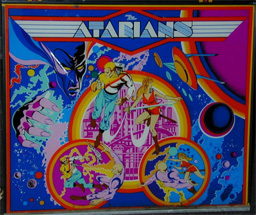 Q: Did you work with Mark Ritchie on The Atarians? He stated at the Chicago Expo
2012 that half of The Atariansí production run came back to the factory because Atari had received a bad batch of plywood used to make them.
Q: Did you work with Mark Ritchie on The Atarians? He stated at the Chicago Expo
2012 that half of The Atariansí production run came back to the factory because Atari had received a bad batch of plywood used to make them.
Dennis Koble: No, but I remember Steve Ritchie making regular appearances in the lab where I worked with the game. Steve was a rather "in your face" individual back in those days. He thought he was surrounded by "uncool" idiots (which was probably true since we were by-and-large nerds in those days). He had a very high opinion of himself and a very low opinion
of those around him...lol.
I remember working primarily with Dan Corona (a technician) and Jackie Fowler and Cynthia Villaneuva (both wire wrap girls) in the lab. I was "on loan" from the Arcade group and spent probably no more than 2 or 3 months there. I think Steve Calfee (an old college friend) took over from me on the programming end and eventually Eugene Jarvis was hired as full-time pinball programmer.
Q: I know both Mark, Steve, and Eugene worked on Superman. The IPDB page for Superman includes several comments from Steve about the development of it, and why he ultimately left Atari for Williams.
Dennis Koble: After I returned to Atari coin-op, I kind of lost touch with Steve. He was never really a friend as I indicated above. As for Eugene, he became a friend years later when he had moved over to coin-op and Williams. I donít actually recall ever meeting him when I was at Atari. I donít remember anything about the sounds in the pinballs, but I expect that was because I was working on that in the early days of pinball and we were still working with wire wraps and just trying to get the basic mechanical and electrical stuff working.
Q: Were you involved with Sprint 4, Sprint 8, or Monte Carlo?
Dennis Koble: Sprint 4 and Sprint 8 were Steve Calfee. I had gone from the Coin-Op division by that time and was in Consumer. I still collected quarterly royalty checks from Coin-Op from the earlier games which galled some in Coin-Op and some in Consumer. To be fair, it wasnít a problem for most people, but you have to consider there was already a rivalry between
Coin-Op and Consumer by that time.
Now Monte Carlo, although I recognize the name, Iím not sure about. There was a one-player driving game developed in Grass Valley that was pure hardware (no computer code involved) that was released shortly after Sprint One (maybe it was Monte Carlo?). I didnít know the people at Grass Valley at that time so I canít tell you much about itís development (Ed.: I think the game in question is
Gran Trak, which preceded Sprint). They also did a two-player version as I recall. They
were both released under the Kee Games logo (Atariís own Joe Keenanís version of Atari to circumvent the industry preference not to order too many games from one manufacturer).
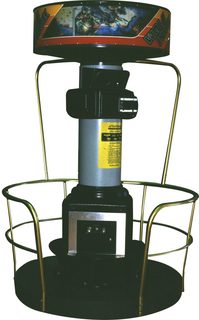
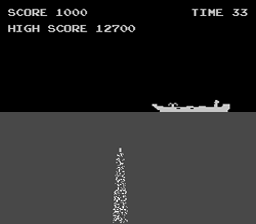
Atari's unreleased Wolf Pack arcade game.
Q: I remember Sea Wolf quite clearly in the arcades - that and Breakout were the big hit games at the time. What do you recall about Wolf Pack?
Dennis Koble: Sea Wolf was one of my favorite games of that era. I loved how you got immersed in being in a sub and tracking those bad guys. Atariís version had an actual periscope but was beset with mechanical problems which were never solved as I remember. Probably also it was partially my fault, as my intent was to recreate Sea Wolf (since I loved it so much) and then alter it to give it some originality. In those days, most of us worked on more than one game at a time and I think perhaps I got distracted while doing other games as the mechanical problems dragged on.
Q: I remember hearing it had real water in it (in a partition between the player and the monitor) to create the illusion you were underwater. There were a lot of 'firsts' with that one, such as voice synthesis! Shame it was never released.
Dennis Koble: It looked great but it wasnít very fun while I worked on it. Just could never take it to the next step, I guess.
We had a guy there by the name of Dave Stubben who was a giant of a man. Whenever we needed to try out a mechanical aspect of a cabinet or a mechanical prototype, he was called over to see if he could break it, since conditions were very harsh out in the real world. He would usually destroy the item in question and that caused many an Atari game not to be released over the years. Owen Rubin was the software breaker and Dave Stubben was the cabinet breaker - an awesome pair indeed between them.

Monitor bezel for Atari's unreleased
Dirt Bike! game. This was in artist Steve Hendrick's possession.
Q: In the book, "Game Design: Theory & Practice", Ed Logg had this to say about Dirt Bike:
|
The game was started by Dennis Koble ... it was a game similar to Sprint except you drove a dirt bike and the control was a set of handlebars that could be used to steer the bike instead of a steering wheel. We field tested the game and it earned enough money to make it good enough not to kill outright, but not good enough to make it into production. However, I had made Super Breakout at the same time I was working on Dirt Bike. No one at Atari had ever worked on two games at once before. Super Breakout had earned a large amount of money, and this probably led to the decision not to build Dirt Bike. I was not disappointed considering the success of Super Breakout. |
Dennis Koble: I was the initial programmer on Dirt Bike and worked on it for a few months. Later, Ed Logg took over since I went over to the hand-held division, but it never made it to market, as apparently it did not test well enough in playtesting. I remember the control durability was a problem also as Dave Stubben probably demolished the controls regularly in this game. Atari wasnít really good at games that involved mechanical aspects; those were more of the province of companies like Williams, Stern, and Gottlieb, who had years of experience at building games with mechanical aspects. This holdover at mechanical inexperience carried over to Sente, which mainly had ex-Atarians working there and was the primary reason Shrike Avenger and some of Senteís forays into amusement park rides or products didnít gain any traction.
Q: A recent book about Atari mentioned you helped design and build a custom 'burn-in' oven for testing circuit boards. I hesitate to even ask this, considering the source and the absurd idea of Atari hiring a programmer and putting them to work building a giant oven...
Dennis Koble: LOL, that was definitely NOT me. I never designed any stinking burn-in ovens (as they say).
Q: As I suspected. Excuse me while I put that book back in the fireplace where it belongs :) Do you recall any other unreleased games you worked on at Atari?
Dennis Koble: There were quite a number of other games I did at Atari, including a table-top series of sports games that never made it to production.
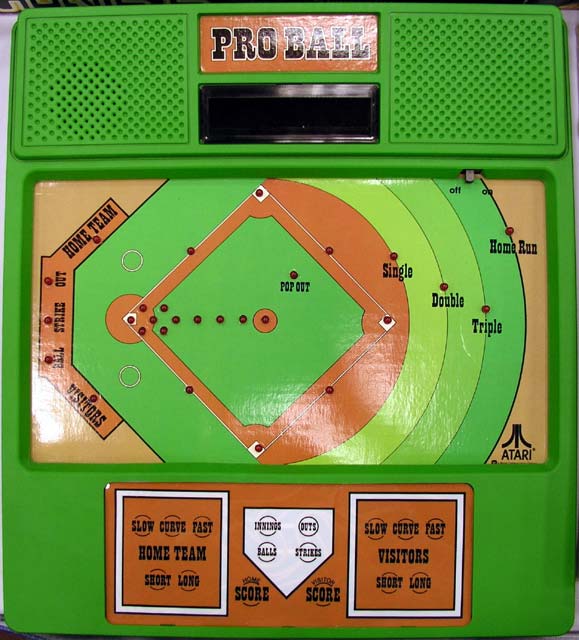
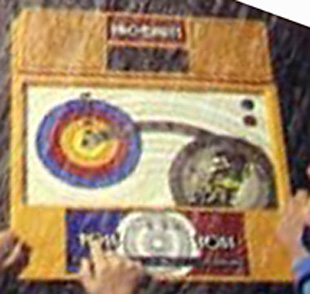
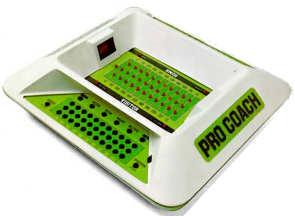
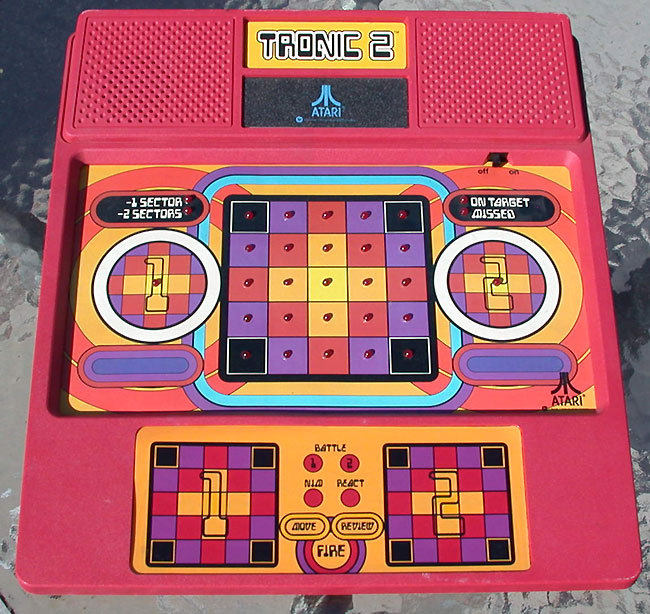
Atari's unreleased hand-helds Pro Ball, Pro Darts, Pro Coach, and Tronic 2.
Q: I know one was the unreleased Pro Coach. This was part of the ďProĒ series, along with Pro Ball and Pro Darts, which were unreleased as well (more information can be found at the HandHeld Games Museum site). A flyer for Pro Coach can be seen in my interview with Roger Hector. Do you recall what year you worked on this, or who designed the other 2 games?
Dennis Koble: Thank you for reminding me of those other titles. I designed and programmed most of the games in that series with input from a variety of people - most notably Roger Hector for the football game. Atari had split out that group into a separate division with a small group of people (about 10?), including myself.
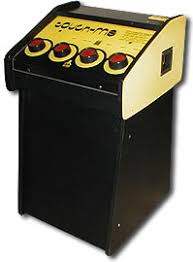
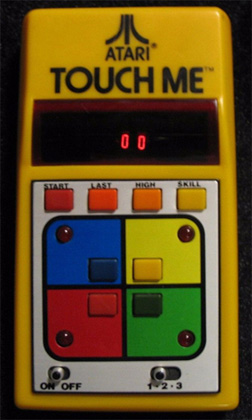
(LEFT) Atari's 1974 Touch-Me arcade game; (RIGHT) Atari's 1978 Touch Me hand-held.
Q: Thereís also one called Tronic 2 and rumors of 2 others - one called
Pulsar and a (unnamed) bowling game. Did you program that one as well? It's believed those and the Pro series games were cancelled due to manufacturing problems, and that even Touch Me had problems with the case (which
was apparently designed by a firm that made cases for calculators).
Dennis Koble: I know I did all of them but even looking at the pictures I remember very little about them. I guess it has to do with the very short lead times I had in designing and programming those titles. I do believe they were done by me in retrospect and by looking at the picture links. If itís any interest, Roger Hector did the art on the Pro Darts box and it looks
like Jim Kelly did the art on the Pro Ball box. The (LED) hand-helds were done in a separate division and in a separate building.
Since I was never involved with the manufacturing of any of the games it is quite possible there were case problems. The procedure in those days was to make very expensive machined metal molds and then make the plastic parts from those molds. I think however (and Iím probably wrong) that was all done in the U.S. The ROMS came from Southeast Asia and those were the long lead time and expensive items. I think maybe it was just Atari money problems that killed the hand-helds. I remember hearing that 10,000 of each game (except Football) were made, although I never saw any of those. The Football game (of which I still have one of the working fiberglass prototypes) case was quite different and I donít think more than a few prototypes were ever made.
Touch Me, however, was quite different. I donít exactly remember still being at the hand-helds place when I made it. Perhaps it was an attempt to salvage some of the investment made into the failed hand-held division. I think I recall that the case was indeed a cheap calculator case re-purposed into the game. It was super cheap to make and we sold millions of them.
Q: How did Touch Me come about? That was the only hand-held Atari ever released.
Dennis Koble: Touch Me was supposed to be a copy of Milton Bradley's Simon (which was already on the market). The timeline as I recall it was that Simon was a rip-off of an Atari arcade game. I was asked to do a rip-off of Simon but I remember being angry and offended by the concept that we had to create a rip-off of a game that had ripped-off Atari in the beginning. And so in typical passive-aggressive fashion which suited us programmers, I decided to make as an exact copy as I could of Simon as my form of protest (I know, I know, this sounds so petty but there it is).
Q: Youíre correct. Touch Me was an Atari arcade game that was released in 1974. Simon was created by Ralph Baer. Itís thought by some that Simon was Baerís response to Atari ripping off his Odyssey game system with Pong.
Dennis Koble: Your comment about Ralph Baer is funny. It seems every idea is an original and therefore is being ripped off by someone. Who knows? It may be true.
Q: Actually, he admits in his book, Videogames: In the Beginning, that Atari's Touch Me was the inspiration for Simon. He thought Touch Me offered good gameplay but the execution of it was terrible, and he set out to do a better version of it.
Dennis Koble: I never knew who did the original arcade version of Touch Me. I think it was a hardware-only game and perhaps was done in Grass Valley.
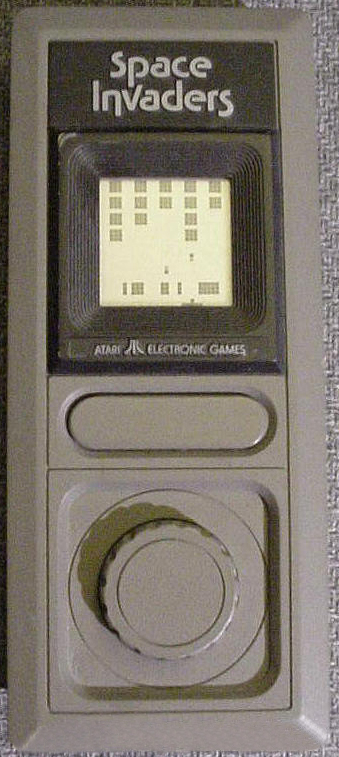 Q: Were you involved or know anything about the Space Invaders and Super Breakout
LCD hand-helds Atari planned in 1980?
Q: Were you involved or know anything about the Space Invaders and Super Breakout
LCD hand-helds Atari planned in 1980?
Dennis Koble: I never actually have seen one of these before today (or even a picture of it). The LCD games were done in the VCS consumer division while I was Manager there, but I only remember just a little about Super Breakout in particular because Tod Frye, who programmed it, had trouble focusing on deadlines at the time and I had to ďhandholdĒ him in the evening to try to
finish it.
Tod was (and is) a very smart guy, but in those days he had a hard time focusing on the task at hand and therefore was not good at meeting schedules which Atari (under Ray Kassar) was focused on. It galled Ray Kassar to no end that he had to rely on a bunch of flakey-ass programmers to run a 5 billion-dollar-a-year business. To say there was a clash of cultures is a gross understatement.
Q: If I recall, Tod Frye mentioned in an online keynote video that you were the CES Manager when he was given VCS Pac-Man to do. As far as I know, Tod started Pac-Man around May 1981 (btw, that same Atari book incorrectly claims Pac-Man was Tod's first game at Atari!). You mentioned Imagic was formally founded on July 17th, 1981. Do you recall when he started it, or what month you
left Atari?
Dennis Koble: No, I do not, although I expect it might be in the public record as when Imagic was formed. I left Atari during those times to start Imagic with a number of other people. I wasnít away long from Atari when we founded Imagic. It was all a whirlwind. It is possible Tod did start VCS Pac-Man while I was still Manager, but since I canít remember who took over for me, perhaps that was during the time when I told Atari I was leaving. I think I probably gave Atari a couple of weeks notice, but I donít really remember the details.
Q: Frye has often stated in his regards to his Pac-Man game, the reason he didn't use a black background for the game (as the arcade version does) was Atari had a rule (or there was a guideline. as his reason usually flips between the two) against games having a black background, unless they were space games. I've asked several former Atari VCS programmers this question, and none of them ever recalled this being the case. Do you recall anything about that?
Dennis Koble: I don't recall there ever being any sort of rule or guideline about the background color for any of the games. In those days, very few aspects of any game were codified into a rule or law. There were bounds of good taste and what might not be appropriate for families or kids, but those again were left to the discretion of the designer. I am sure Marketing would have stepped in, in case of anything that might have negatively affected sales or put the company in a negative light, but I honestly don't actually remember that ever happening. We used discretion in the making of the games and so I think it never became an issue.
Q: Did you interview Howard Scott Warshaw when he applied at Atari? He talked about how he was initially turned down after his first interview and practically begging to be hired (for less pay and even on a probation period initially).
Dennis Koble: Yes I was Manager of the VCS group when he applied for a job there. I actually hired a large number of people while I was the Manager there. I remember Howard as being very personable and with impeccable credentials, as he was working at HP at the time. We just didnít get applicants from people that had college degrees or any kind of industry experience whatsoever (I know itís hard to believe, but people didnít consider a job in video games as a viable career option back then). So naturally I tried to discourage him away from the job. He was making way more money than I could afford to offer him and he was WAY over-qualified for the job. He was very persistent, however, and eventually talked me into offering him a job with less pay than he was making. I still see him from time to time, most recently at the last PRGE show, and he is still very articulate and projects an air of competence and confidence. He was always a smart guy and his personality and ability to communicate effectively have always been his strong assets.
Remember that Howard and all the other designers were just kids in those days. In fact as the Manager, I was the oldest person there, being about 28-32. Most were single at the time and thus of course many of them did stupid things as the young are wont to do. It's part of growing up, and most of them were in the 18-25 age range (so I'm calling them kids...lol). They are were all pretty good people (some better than
others) when I was Manager of the consumer games. I had come over originally from Coin-Op and a stint doing electronic hand-helds and board games and helping the pinball group at its beginning, so I was young and inexperienced also, especially as a Manager.
When I first came over (to CES), I worked under a older guy named George (last name escapes me) but he left shortly thereafter due to the fact that the management team (as was Atari) was expanding rapidly and George didn't really know how to play the corporate game correctly, so I became the head of the consumer division. Shortly thereafter, our group became too large as Atari was expanding rapidly, and so one of the people in our group, Dale Yocum, moved over to manage the computer
division, and I managed the consumer games division (for about 2 years). As we grew, I remember spending most of time interviewing and hiring applicants, meanwhile hoping that the programmers were doing their jobs. I was very "hands off" and took my role as a facilitator and champion of the programmers. It made me likeable to the rank and file and less so to upper management. Whether it was the right approach or not I cannot say, but I quickly came to understand I didn't really
want to manage people (it's a lot of work and a lot of heartbreak), and left to be a co-founder of Imagic, at a time when Atari was doing about 5-1/2 billion dollars a year.
A very enthusiastic tech support guy named Steve Wright took my place as he was very likeable (at the time) and knew how to convince the higher-ups that he could run the games group. Unfortunately, he was about as bad at it as I was (this is from hearsay btw, since even though I knew Steve from my time at the company, I did not know how he was as a Manager). The group meanwhile exhibited all the signs of "the too much success overnight syndrome". Steve's approach used a
combination of the carrot and stick credo. He was very generous (probably too much so) in sending money and perks to the group in hopes that the group would respond positively. Initially it worked, of course, but as with all such approaches, it gave them a sense of entitlement, and even though the amounts of money were great, that wasn't enough. Steve in his job was given directives to force the group to meet certain demands, like being on schedule, a Japanese-style office
arrangement (probably his own idea), and various other restrictions. Basically the group (as a whole) became somewhat prima donnas at that point. They had Atari over a barrel and they knew it. They were flooded with money and perks, and they used their leverage to get more of the same. This of course upset upper management to no end, but the programmers had the leverage and they used it. Atari needed games in great quantities and they were the only group that could
do it.

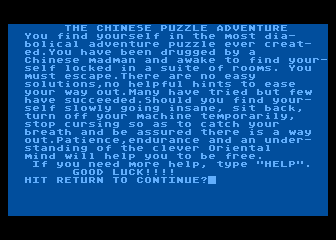
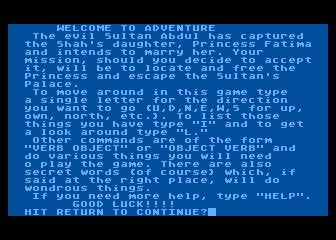
Atari 400/800 APX Avalanche, Chinese Puzzle, and Sultan's Palace.
Q: As you mentioned, before leaving Atari (in 1981), you became the Manager of Consumer Software. You also programmed 3 games for the Atari 400/800 computers that were released under the APX (Atari Program Exchange) label: Avalanche (1980), Chinese Puzzle (1981), and Sultanís Palace. (1981). Were these the only 3 Atari computer games you did?
Dennis Koble: That is correct I believe, but my memory is not perfect. I believe there were a few others perhaps, but I canít remember the details at the moment.
Q: I know Bob Polaro did a bunch of APX titles as well in 1981. He also did several games the year before, under the Atari label. What's interesting is, he was credited for the APX games but not the non-APX titles. And yet, the same year he did the APX titles (1981), he did Defender for the VCS and wasn't credited for it (although he hid his initials in it via an Easter egg). I'm not sure how programmers were able to get open credit for APX titles, but not anything else.
Back in 2013, someone found a prototype floppy disk called Marketing Adventure. It's actually a compilation of 4 games:
Space Ship Adventure - author unknown
Sleazy Adventure - Bob Smith's
Marketing Adventure - Rob Fulop's
Sultan Adventure - yours
Rob mentioned he wrote his Marketing Adventure game over a long weekend:
| I remember goofing off with a text adventure engine on the Atari 800 over a long weekend and some teasing reference to Dennis Koble's office being littered with racing forms since he sometimes went to the race track at lunch time. |
All of the games seem to use the same text-adventure engine. Do you recall how these games came about?
Dennis Koble: Yes, I remember those games (at least mine) fairly well. They were intended to be part of the APX offerings that was to come later but were deemed (in least in my case) to be unsuitable for the public. I don't think I ever intended it to be a regular product. It was more intended for friends and colleagues who wouldn't be offended by its rather racy content.
I don't know about Rob's and Bob's or the other one but it's possible they were in the same vein.
My game and the Chinese Puzzle Adventure (published via APX), and possibly the other ones too, were based on an "Adventure" system someone wrote in order to create a modular text-based adventure system. Basically it allowed anyone to create a text set and a logical road map as it were to make their own adventure. We were all very familiar at that point with Zork and so a number of us used that system to create our own fun adventures. I don't think any of us ever actually
thought of using it for a commercial game or anything but we had fun creating them.
The Chinese puzzle game I designed was never actually intended to be "fun", believe it or not. My goal when I created it was to create the most difficult text-based adventure game ever. It was never intended to be marketed, either.
When I was Manager of Consumer Games Software, I was asked many times by consumers who were just getting into computers via the Atari 400/800 if there was a way to be able to publish their software and game creations so that other computer users could play and use their stuff. So I approached Chris Crawford (who worked for me) and Dale Yocum (who recently had become the head of Atari computer software) to help me create the idea of the Atari Program Exchange to allow those fans
outside the company to "publish" their titles. Those two were both very interested in making APX a reality, and I kind of stood back and let them do their thing.
Initially they needed titles, of course, and that's why I gave them Chinese Puzzle Adventure and a color version of Avalanche, to help them build their initial base of available software. Interestingly I found out a few years later that Lee Actor (who never worked for Atari btw) had published his Advanced Music System (AMS) software through them and had received royalties from a dedicated fanbase.
APX turned into a huge success and while it never really made any money, it was invaluable to Atari to help promote the 400/800. Nothing else really existed like it at the time.
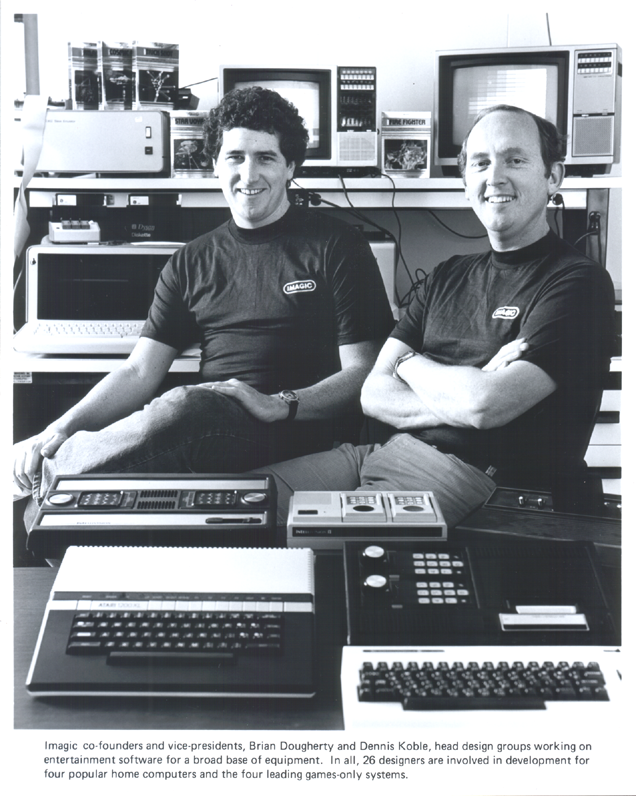
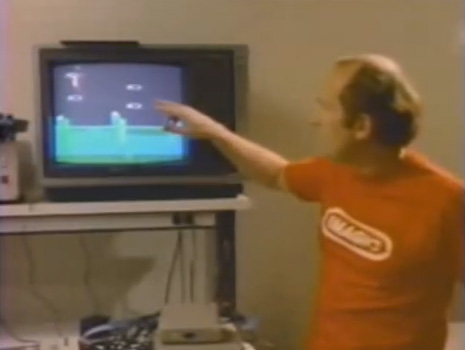
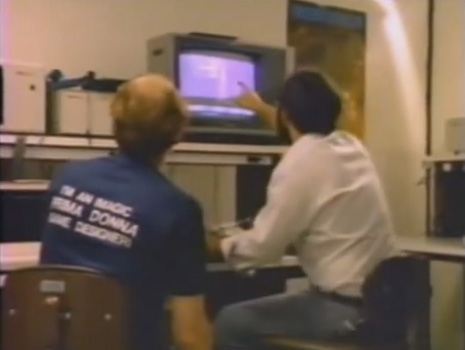
(LEFT) Dennis showing an early version of Atlantis; (RIGHT) Dennis (wearing an "I'm An Imagic Prima Donna Game Designer" shirt) working with artist Michael Becker.
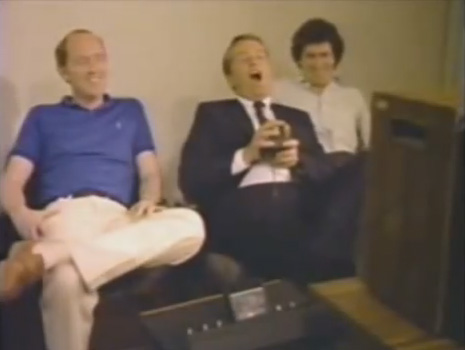
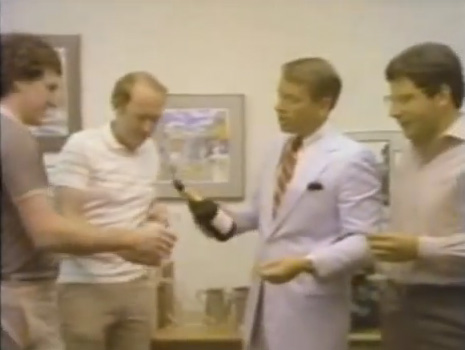
(LEFT) Dennis and Brian Dougherty watch Bill Grubb try his hand at Atlantis; (RIGHT) The original founders celebrate (prematurely, as it happened) prior to Imagic going public.
Q: After Atari, you left to found Imagic with Bill Grubb, Brian Dougherty, and Jim Goldberger. Rob Fulop mentioned in my interview that, ďI was in the middle of [working on a 1st-person bombing game] when I was approached to be a founder of Imagic.Ē Iíve seen other articles in the past mention him being a co-founder of Imagic as well, but itís interesting to note the PBS Enterprise show about Imagic made no mention of him being a co-founder. An article in the January 1983 issue of Video Games with you and Bill Grubb mentioned there were 2 other Atari designers (Rob Fulop and Bob Smith) and 3 other software/hardware people (not named), for a total of 9 people that founded Imagic on July 17th, 1981, but the first meeting to discuss forming Imagic was with the first 4.
Dennis Koble: There were about 9 people (I think a few more actually) that founded Imagic. There was the Atari contingent consisting of Bill Grubb, myself, Rob Fulop, Bob Smith, and a few others, and then there was the Mattel contingent consisting of Brian Dougherty, Jim Goldberger, and a number of Mattel programmers. However, the initial group that secured the funding was myself, Bill Grubb, Jim Goldberger, Brian Dougherty and a lawyer that Bill knew. We were the ďprincipalsĒ as it were. Rob and Bob held a slightly-higher position, since the Atari group was much smaller than the Mattel group and we also put out the first Imagic games.
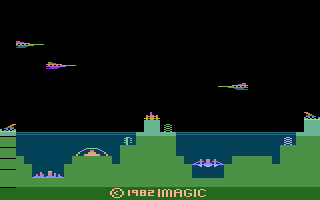
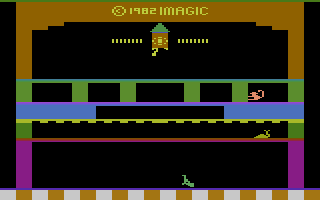
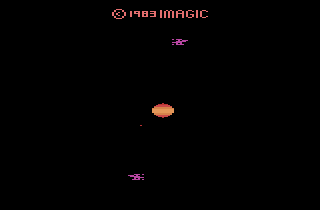
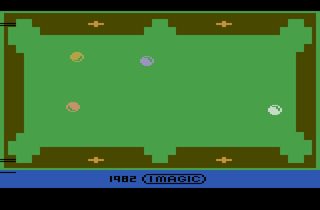
Imagic's Atlantis, Shootin' Gallery, Solar Storm, and Trick Shot for the Atari VCS/2600.
Q: At Imagic, you were the Vice-President of Software Development. During your time there, you designed 4 VCS games that were released: Atlantis, Shootiní Gallery, Solar Storm, and Trick Shot. If I recall correctly, Trick Shot was part of the first group of games that Imagic released. Someone claimed Shootin' Gallery was your version of Carnival, though this was a common midway target shooting game for decades before being made into video game versions. The same person also claimed Solar Storm was based on your Avalanche game. Though I can see some similarities, there's also some similarities with Space Invaders and other "slide-n-shoot" games. Can you talk about these as well?
Dennis Koble: Yes, in addition to managing the Atari group, I also programmed the games you mentioned since I did not want to be relegated to only a management role.
Q: Can you talk a bit about the development with these games. Did they require any innovative programming tricks, or were there other games (possibly in the arcade) that were the inspiration for them?
Dennis Koble: I did those titles while I was VP of software development at Imagic. The Trick Shot title was very difficult for me as I had a minor in Physics during my college years and I found it very difficult to make the physics work in a VCS. Of course, I never really was able to make the physics work, and what you see is an approximation to make it seem that the balls followed the laws of physics. The others were my own ideas developed at the time. You have to remember that those were early days when it was relatively simple to come up with fresh ideas, since everything hadnít been tried umpteen times already.
Q: Iíve heard others such as Rob Fulop mention the great thing about how Atari was structured was that everyone worked in a big, open Ďlabí area and you were able to see what everyone else was working on and provide them help or criticism (with suggestions or play-testing). Iím not sure when that environment changed, but I know Howard had his own office sometime in 1982. Was the open-lab layout still there in 1981?
Dennis Koble: We had an open lab layout when we were at the main Atari building and I was Manager. There were several labs with 2 VCS development stations in each lab. The employees had separate offices which generally held 2 people each. In my last days there as Manager, I was involved in designing the new development offices in a new building a couple of blocks away. However, I believe I left before I moved to that building with the group. Many of the recollections from Howard and Rob were I believe from that later, newer office. Rob Fulop and Bob Smith did not initially join me at Imagic until a few weeks later and so likely had offices at that new building.
Q: Do you recall the sales figures for your Imagic games? Iím guessing Atlantis was your best-selling Imagic game and sold at least 1 million.
Dennis Koble: Atlantis actually sold over 2 million cartridges and was the second-most popular game at Imagic; number one of course was Rob Fulopís Demon Attack. I donít remember the actual numbers for Demon Attack, but it was well in excess of Atlantis - probably a minimum of 3 million or more. I seem to remember the number of over 4 million but that could just be my memory playing tricks on me.
When Imagic launched its first VCS cartridges, we had a sweetheart deal with Magnavox and we paid no royalties in the deal. Bill Grubb was a personal friend of some of the management at Maganvox and thus was somehow able to make the deal with them.
Q: Did you have any involvement with the Intellivision version of Atlantis?
Dennis Koble: None whatsoever.
Q: I know Michael Becker was the Art Director there and helped you with Atlantis. Besides Michael, did you work with any graphics or sound artists, either at Imagic or Atari? If so, do you recall who helped with what?
Dennis Koble: Each game was a team effort at the beginning, even though there was only one programmer doing it. Every game made then incorporated various suggestions for improvement from the many other employees in Engineering. Owen Rubin, for instance, was renowned for his ability to find bugs. Others, like Lyle Rains, made very valuable gameplay and user interface suggestions. Atari was very much like a big family back in those days, which accounts for the endless reunions that are still held by and for former employees. This was also true at Imagic and I am sure at Activision.
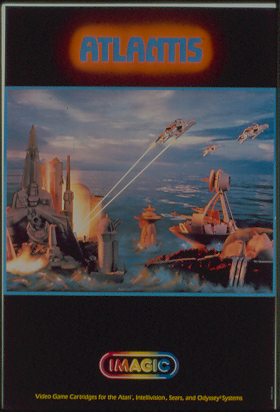
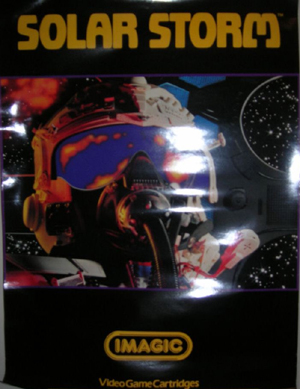
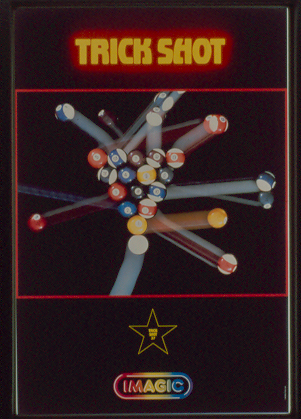
Posters for Atlantis, Solar Storm, and Trick Shot.
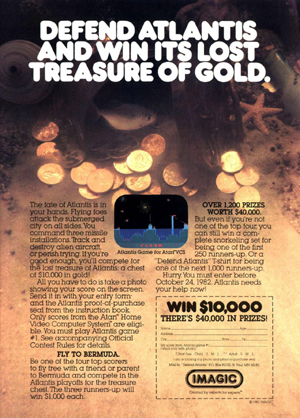
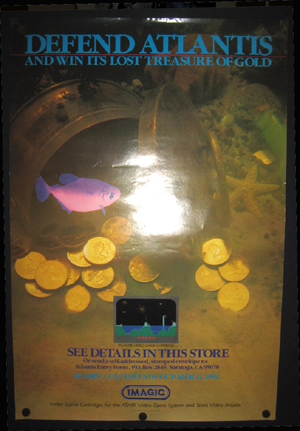
Ad and poster for Imagic's "Defend Atlantis" contest.
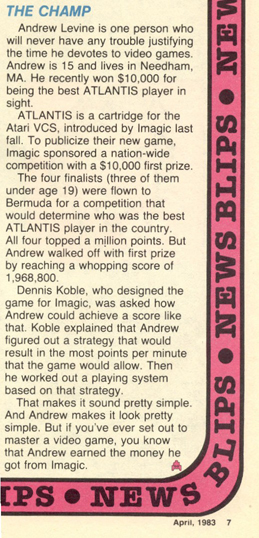 Q: Regarding Atlantis II (the contest version that was made), do you recall how many copies were made? The February 1983 issue of
Electronic Games notes there were over 80 players who qualified for the 'semifinals' (pg. 20). The top 4 players of this runoff earned a free trip to Bermuda for a showdown (using a standard Atlantis cart), with the overall winner nabbing a cool $10k in gold coins. As far as anybody knows, the carts all used ROM chips (not EPROMs).
Typically, large production runs of those are done because of the cost involved, but Atlantis II and Rob Fulopís game, Cubicolor, both used ROM chips and appear to have been produced in very small numbers Ė apparently less than 100 for both.
Q: Regarding Atlantis II (the contest version that was made), do you recall how many copies were made? The February 1983 issue of
Electronic Games notes there were over 80 players who qualified for the 'semifinals' (pg. 20). The top 4 players of this runoff earned a free trip to Bermuda for a showdown (using a standard Atlantis cart), with the overall winner nabbing a cool $10k in gold coins. As far as anybody knows, the carts all used ROM chips (not EPROMs).
Typically, large production runs of those are done because of the cost involved, but Atlantis II and Rob Fulopís game, Cubicolor, both used ROM chips and appear to have been produced in very small numbers Ė apparently less than 100 for both.
Dennis Koble: Well I canít deny that is a ROM on the Cubicolor PCB board. I donít know what Rob did to make them. You should ask him directly and maybe he could tell you. We used EPROMs in the lab for development and testing and for short game runs while ROMs were fabricated overseas in large numbers with long lead times. Perhaps by that time there was a way to make small runs of ROMs inexpensively? Maybe we had such a good relationship with the chip manufacturers at that point there were willing to make small runs for us since we had purchased millions of chips from them?.
Q: The April 1983 issue of Blip (pg. 7) states 15-year-old Andrew Levine won the contest with 1,968,800 points (thereís also a quote from you describing how he developed a strategy to get the most points per minute). I interviewed someone (Doug Leighty) a few years ago who qualified for the contestís tiebreaker and was sent a copy of the game and an Atlantis shirt. He submitted a score for it, and later received a letter stating the contest was cancelled!
Dennis Koble: Hmm.. Iím not aware the contest was ever cancelled. I traveled to Bermuda for the contest and met several of the contestants and was properly awed at how well they could play the game - much better than me! Since however I was not involved in the marketing or business end of Imagic I canít say for sure what the ultimate disposition of the contest was.
Q: Bob Smith mentioned at last year's PRGE about making a Dungeon game for the Atari 800 at Imagic and that you were working on a VCS version but that "those were immediately abandoned". How far along was your version?
Dennis Koble: I very vaguely remember working on a dungeon game for a short while on the VCS, but as Bob indicated, it was never finished. What intrigued me was coding up the "1st-person" wire frame view which I may have gotten working. I do remember Bob working on something similar later and getting further along, but all of these are vague memories.
Prior to all of this, there was an Internet of sorts that Bob and myself and most of the games people had access to. I don't remember much about it, but I think you had to have special hardware and a special monitor. It was all vector-based and had just black-and-white wire frames, and there was this game which we all loved that was a very early dungeon game. That inspired all the later dungeon games, including one on the Apple II that intrigued us all pre-400/800.
Q: Imagic was certainly aggressive during its time, and they supported a slew of different platforms, perhaps too many? In the Video Games article I mentioned, Bill stated he felt the real competition was between Activision and Imagic, and that one or the other would very likely still be around years later (how fortuitous). By 1984 you were at Sente Technologies (later Bally Sente). The market crash claimed nearly every video game company at the time, even Activision (which went through some name and ownership changes before coming back). What could Imagic have done differently to weather that storm?
Dennis Koble: We could have survived if we had not pre-ordered so many cartridges for the upcoming Christmas. Back in those days you had to order your cartridges (ROMS) from overseas and then ship them to the U.S. This process took many months, as capacity in Asia was limited and Atari and Activision and ourselves were all competing with one another for the limited cartridge supply. So what I am saying is that there is probably no way we could have survived because that would have required foreknowledge of the state of Atariís sales, which were plummeting due to oversupply of the consumer market.
Q: Thereís also a question about who actually owns the Imagic library now...
Dennis Koble: That has passed through many hands at this point (Activision, Atari, Vivendi, and others) that I am not qualified to say what happened to the rights of the Imagic games.
Q: Do you remember what early or tentative titles your other games had (if any)?
Dennis Koble: No.
Q: In the March 1983 issue of Electronic Fun with Computers and Games (page 49), you spoke of a ďjungle gameĒ ("We had a game idea for a jungle theme, then Pitfall! came out from Activision. That happens more often than you think."). Do you recall who was working on this? The same article also mentions, "Imagic also considered a fortune game until Odyssey introduced The Great Wall Street Fortune Hunt."
Dennis Koble: I donít recall either of those games you mention, unfortunately.
Q: Do you recall any other titles that either yourself or other programmers at Imagic were working on that were never released, or finished? I know of a few (some of which are mentioned in my Michael Becker interview):
Air Traffic Controller Ė Brad Stewart
Dungeon Ė Bob Smith (at the 2015 Portland expo he mentioned working on a version for the Atari 800 and recently decided to do a VCS version)
Beauty and the Beast (port of Intellivision title)
Microsurgeon (port of Intellivision title)
Safecracker (port of Intellivision title)
Thurror
Dennis Koble: Unfortunately no. Many of the unpublished titles never made it to marketplace due to funding running out, creative differences, licensing problems, etc.
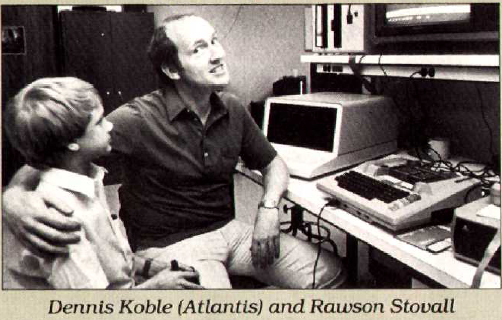
Q: Where did you go after Imagic folded?
Dennis Koble: I spent a short time (a few months) with Rob Fulop afterwards, at a small consulting/games development company we started called Advanced Program Technology. We rented an office together and set out to secure some video game contracts. That process took a bit longer than we initially anticipated. Rob was single then, but I had responsibilities with a wife and child and needed a "regular" job. There were other gigs of course in those years. Separately I worked for Bally (along with 6 or 7 others) as an independent contractor. I think I joined Bally Sente (formerly Videa) as Director of Software working on coin-op games and kits. I joined them the day after Bally acquired them.
Much later, when APT morphed into PF. Magic, Rob asked me sign over my original stake in APT since that company needed to clear up the details of ownership of the original company. I had become quite successful at that time due to Lee Actor and myself starting Polygames, which left me in a solid financial position. In short, I really didn't need any monies that might be generated by PF. Magic in their future and since Rob was still a very good friend and business associate, I didn't have any problems signing over my position in the original company to him. Also, I felt that Rob had contributed almost 100% to the success of our original company and had taken the bulk of the risk over time in building what was in effect his company later.
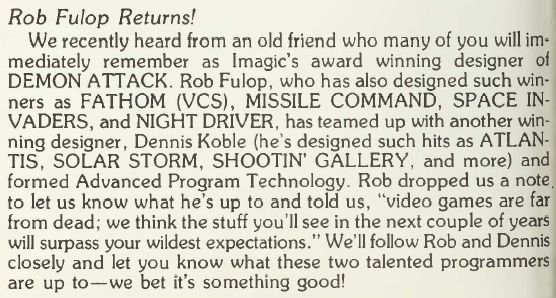
News blurb from the May 1984 issue of
Computer Entertainer.

Article photo from the August 1985 issue of
RePlay (pg. 41).
Q: Do you recall what you worked on at APT? And would it have been for the VCS/2600?
Dennis Koble: So, after that long-winded explanation, the answer to your last question is that we weren't in the position to develop anything ourselves in the early days of APT due mainly to financial constraints. I do recall advertising to the world that we were experts in VCS technology (and a number of other areas) and we sought to secure contracts to develop games and other software. Since I only stayed on at APT for probably no more than 6 months or so, I don't recall us working on or developing anything in that time frame.


Sente's Stocker (LEFT) and Night Stocker (RIGHT)
Q: Mini Golf, Stocker, and Night Stocker were the 3 games you did at Sente that I know of. Stocker seems like a natural evolution of your early Sprint games, which were clearly based off Atariís first driving games, Gran Trak 10 and 20. Night Stocker is probably the first (and only?) driving game that also includes a light gun. That was released a year before Atariís RoadBlasters, but a year after a laserdisc game called Road Blaster. Do you recall the inspiration behind that? Those 1st-person driving +shooting games are what I always imagined what Warren Robinettís Slot Racers game would be like (the catalog artwork for it certainly helped); it's a genre now called 'vehicular combat'.
Dennis Koble: I donít exactly remember the entire timeline of Night Stocker but I remember I was huge fan of RoadBlasters which came out later (I had no involvement with that game other than much later, doing the Sega Genesis version with Lee at Polygames for Tengen). I donít know if RoadBlasters was inspired by Night Stocker or another game. What I do remember is Howie came up with the idea for the light gun. It was the only Sente game that ever used the gun and I remember struggling a bit to find a regular use for the gun. I do remember an "Ah ha!" moment one day, though, when I discovered that I could turn the gun into a machine gun by shortening the reset time for the gun. I was so excited, since it was such a rush. I remember rushing into a neighboring lab where Ed Rotberg and someone else (maybe Roger Hector) were working, and excitedly ushering them into the lab where they could try it. I remember being so pumped up by that. It was one of those moments when you know it has all worked out and you are in the right place at the right time. I know I am probably over-remembering the excitement of the moment, but it has stuck in my memory all these years.


(LEFT) Atari's 1978 unreleased Atari Mini Golf; (RIGHT) Sente's 1985 Sente Mini Golf
Q: There was an unreleased game at Atari back in 1978 called Atari Mini Golf. Was that the inspiration for your Mini Golf game?
Dennis Koble: No. I don't recognize that screenshot of Atari Mini Golf at all. Or perhaps I did (then) and I thought we could do better with newer technology? I don't really know.
Q: According to the notes in MAME, you also worked on Shrike Avenger. It seems just about everyone in the company was involved with that at some point. It was a very innovative game, but as you said, it was highly mechanical and not exactly Senteís forte.
Dennis Koble: I was surprised to see that MAME reference, too. To keep the record straight, I never actually worked on Shrike Avenger; it was Owen Rubinís baby from start to finish. But since we were a very small company at that point and we all knew each other from Atari days, we interacted a lot and played all the games and projects and offered our own 2 cents on each one. Who knows, it is possible I suppose that I contributed some small amount of code to the project. That was not uncommon in those days. Of course the right person to ask would be Owen Rubin as he was the main guy on the project as I recall.
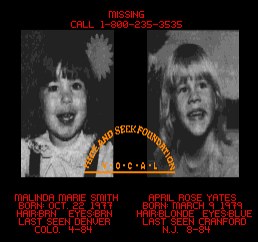
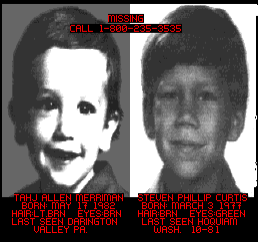
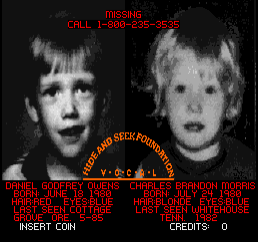
Missing kid photos from Sente's Mini Golf (versions 1 and 2) and Stompin' arcade games.
Q: Do you recall anything about the digitized photos of missing kids in certain Sente arcade games, and how Sente came to include them? So far I've only found 2 Sente games (Mini Golf and Stompin') that featured them during the attract mode. Mini Golf was released in 1985 and Stompin' in 1986. There's at least 2 versions of Mini Golf, and both contain different photos. Howard Delman doesn't recall anything about it. Roger Hector only remembers it was an idea that came in from outside of his dev group, and they implemented it. Lee Actor feels it only lasted a short time, and word came down from Bally corporate that they were cooperating with the FBI and including this info in some of your games, but that none of his games included the photos.
Dennis Koble: Yes, I have some memories of those days but after 30 years I won't be able to guarantee the veracity of those memories of course. I have a slightly different recollection of those FBI photos than do the other people you've asked.
I was the programmer on Mini Golf and, along with Roger Hector, I was the primary designer on the game. It was mainly my idea and creation with Roger playing the role of excellent artist and collaborator. Near the end of the game's creation, I recall someone (can't remember who actually) suggesting that we implement the missing children feature. Although the game was "finished" at that point, I recall adding the switch-controlled feature to a revision of the ROM's. The code
was very simple and it consisted of a timer, a check for whether the feature was enabled via the on-board option switches, and the display of a static screen showing the children.
The option switch enable/disable is why sometimes you "see" the feature and sometimes you don't depending on how tech-savvy the operator was and whether they wished to enable the feature or not. I don't recall the default switch state as shipped from the factory.
The main reason you don't see any updates over time to the children feature had more to do with the economics of how the Sente games were sold versus other arcade companies. If you recall, Sente promoted the "Sente System" which meant that instead of selling a new console (and associated graphics, controls, etc.) for several thousand dollars at the time, the Sente system was based on a modular concept. The modular approach meant we sold the operators a complete console with game just
one time and then subsequently sold "kits" which consisted of a new motherboard (or maybe it was just the ROMS?), new control panels with new controls and art, and a top art panel (above the monitor) for a few hundred dollars.
As you can see, this meant a huge savings for the operators as they did not have to pay for a whole new cabinet, new power supply, new speakers, etc. This also cut down on shipping and handling costs when installing a new game.
The downside of course was that there was not much incentive to produce game updates since the total revenue from each new game was not as great as traditional methods. So.. no new children in the game over time. I hope that answers your questions but you have to remember my memory may be faulty on who programmed the feature. It's just my best memories on the subject.
Q: Do you agree this was most likely something that the FBI approached Bally with? The FBI's involvement in the arcade industry a few years later (with the anti-drug PSA ads) is more well-known, and to a lesser extent, the
recycling ads. But the Missing Kids ads is largely forgotten at this point.
It seems the Hide And Seek Foundation mentioned in the ads is no more. In 2002, a similarly-name Foundation, the Hide 'N Seek Children's Foundation, or Hide & Seek Foundation, was started to promote responsible parenting. In 2010, it joined with Proactive SEO Solutions to bring awareness to Lysosomal disease research.
http://hidenseekca.org/about/history/
http://www.hideandseek.org/
https://www.volunteermatch.org/search/org75195.jsp
As for the 6 kids featured in the Mini Golf and Stompin' ads, the only one that was found that I could verify online was Tahj Allen Merriman.
Dennis Koble: I really don't know who initiated the missing kids project but it seems likely the FBI did request it. You have to remember though that Sente was a very small company and I would be a little surprised if the FBI knew of us directly. Perhaps they approached Bally? And then maybe the request and materials were filtered down to us? Really couldn't say.
Q: Do you recall how the digitized photos were implemented? Did you or someone at Sente digitize the photos? I know Bally released an arcade game in 1982 called Journey (based on the rock band) that included digitized photos of each band member's face, and the technology used to accomplish that was created by Ralph Baer. I don't recall any other arcade games that used digitized photos between Journey and your Mini Golf game.
Dennis Koble: All I know was that I was given a completed screen just like the final product you've seen. Perhaps Roger Hector could shed more light on that subject.
Q: What were some of your experiences working for Atari, Imagic, and Sente? Do you have any stories or anecdotes from those days that youíd like to share?
Dennis Koble: So many stories - some of which have been told elsewhere in video and print. Those were heady days, and the cast of characters was both huge and diverse - many quirky people along the way and many new situations. We were aware that we were part of something special, but no one could foretell the future, so it was a wild ride.
I do have one juicy story I'd like to share with you concerning Dirt Bike (I think it was either that or Wolf Pack).
I remember our technician on the project was rather a crusty, older guy who basically was rather a sour guy in general. He was at odds with a number of people, including one of the other techs. One day, the other tech was asked to do some work on the game in question and came in early to work. As he reached down into the game innards, he noticed that the game had been hot-wired with 110V so that anyone who touched the coin-mech would basically get a huge shock.
Fortunately, he noticed it before he touched the coin-mech and disaster was averted. There was all sorts of speculation at the time about who had hot-wired the chassis. Many thought it was the crusty, older tech, but it was never proven and the matter was quietly dropped. Note that I have left the names out of this narrative as I don't want to open old wounds or slander anyone with unproven allegations. I do recall that the crusty tech told us one time how he had killed a
person one foggy night, as he was driving at fairly high speed and came out of the fog to inadvertently hit a pedestrian. It was kind of an eerie and somewhat scary story thought, I recall.
There were of course many such stories and rumors like that, as I expect there are in many companies that have a large number of employees.
Q: Your comments regarding Rick Maurer at the 2016 PRGE were interesting. I've always felt he was incredibly slighted by Atari under Kassar. His Space Invaders was the VCS's first real 'killer app' and catapulted that system's popularity like no other game had before. I hadn't heard about him getting a mere $3,000 bonus for it.
Dennis Koble: Rick Maurer was an interesting fellow, and quite brilliant, actually. His social skills were almost zero, however, and he was a very difficult person to talk to, but I respected his ability and feeling for games quite a lot. Steve Calfee (who managed Coin-Op at that point) and I "traded" employees back-and-forth a quite while I was Manager of Consumer Games.
Rick Maurer and Carol Shaw were among those employees on lend.
I don't know whatever happened to Rick other than I know he did go to Coin-Op, eventually (Ed.: He traded places with Michael Albaugh, who programmed the Atari 400/800 In-House Demonstration Program before going back to Coin-Op). Most of the people in the know really respected his ability and work ethic. I think he was probably very autistic,
which caused him great frustration at not being able to easily communicate his thoughts to others. Myself and many others thought he got quite a raw deal on the Space Invaders cart. He did a brilliant job on it. I was one of the people who fought to get him anything at all. Looking back, I can see Atari's point of view, but I think Rick deserved much, much more. In many ways, you could call him a trailblazer since he was one of the catalysts that ultimately caused
the publishers to pay decent royalties. He never really benefited, though, and I think we all felt an injustice had been done.
We had a popular meme of the day that we all felt applied especially well to games programmers, and that was the classic "6 Stages of Games Development". I'm paraphrasing a bit, but it detailed fairly accurately the stages of any program development. The one stage near the end I can still remember quite well is "Distinction for the Uninvolved". So true, of course. If a project was a success, it was people who were never really involved that got all the credit and the money and the kudos. Rick Maurer was one of the victims of that meme. He WAS the key guy, but never got the credit or money that went with being the guy who did the brilliant work on the cart.
Q: Where did you go after Sente?
Dennis Koble: After shutting down Sente, Bally decided they wanted a West coast games development center and so they funded a group of independent contractors (all ex-Sente employees) and leased a building and bought the equipment. So I worked for a short time as an independent contractor for Bally in Chicago, along with Lee Actor and a few others. That lasted less than a year. Then they decided to shut everything down but... we all had iron-clad contracts which would easily stand up in court, saying we would all be paid for (I think) 3 years that we estimated each of us would take to finish our individual games. Lee Actor was part of that. So they sent out a hatchet man by the name of Joe somebody to "re-negotiate" the contracts. His job was to shut down the operation and buy us all out. We all got decent settlements, and that was the end of that short chapter in gaming history.
I think I then went to work at Electronic Arts as Producer Director of Software. I worked there maybe a year. When I went to work at EA, both Roger Hector and Rich Adam also got jobs there as producers. Rich was the first producer on a golf game that EA had been working on. I believe Rich was the impetus to hire Lee and myself to do the golf game after I had left EA.
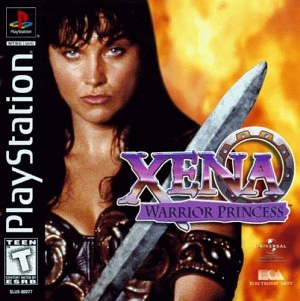
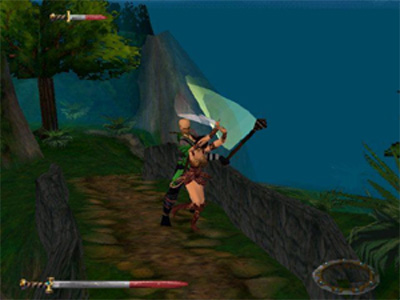
Universal Digital Arts' Xena: Warrior Princess for the Playstation.
Q: Lee mentioned in another interview where he talked about an interactive game division of Universal Studios in San Jose that, you, him, and Roger Hector started in 1997 called Universal Digital Arts. You created Xena: Warrior Princess for EA, for the Playstation, and worked on a sequel to it when Universal shut the office down.
Dennis Koble: The Universal experience was also interesting, and 3 years total. We hired a ton of people and it was my first experience working with a large team (nothing compared to today, of course, but it was still quite a large group of people). UDA was "absorbed" by Universal Studios shortly after our founding since Universal wanted a games group. Our boss at Universal was Paul Rioux. Our contracts were for 3 years, but as the 3rd year neared its end, some of us (myself in particular) left. Universal had suffered a major management change by that point and put extreme pressure on UDA to finish it up. UDA was pretty large at its peak. We had an entire floor at a high rise in San Jose and must have had 40 or more employees. We originally were scheduled to produce 3(?) games, but with budget cuts and a changing marketplace, that was pared down to just one game: Xena: Warrior Princess. The game was finished about the time I left and was fairly successful as it was marketed and published through Electronic Arts. The group was to continue for another 2 or 3 years under Bob Smith, I believe, and may have produced other titles along the way.
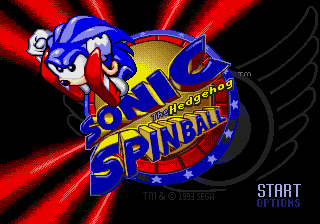
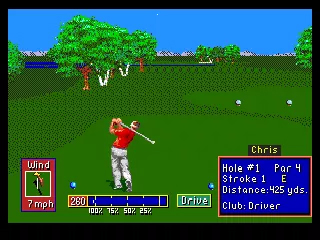
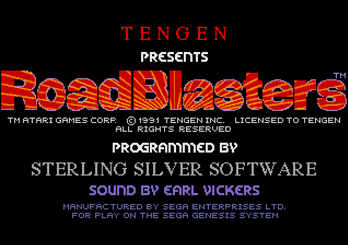
Sterling Silver Software/Polygame's Sonic Spinball, PGA Tour Golf, and RoadBlasters for the Sega Genesis.
Q: After UDA, is that when Lee and yourself started Sterling Silver Software? You also worked on 11 Genesis titles and 1 PC title with Polygames. I couldnít find much information about these, or the exact timeline you were at each company. Can you describe your time there and the games you worked on?
Dennis Koble: Correct. Lee Actor and I formed Sterling Silver Software (later renamed Polygames) and became a game development house. We produced and programmed many, many titles over the 10 or more years of its existence for a number of the major companies/clients. Those include Accolade, Activision, Bally, Digital Domain, Electronic Arts, Sega, and Tengen. We made so many games and versions of Atari games in our time with Tengen, we must have cranked out a dozen or so over a period of about 3 or so years. We were the "go to" guys in the industry for a number of years. When no one else could be counted on to make a AAA game on time and on budget, we could. When Sega was in trouble at their peak, since the 3rd version of Sonic was late for Christmas, we were hired to make Sonic Spinball (which ended up selling millions). When Electronic Arts needed a great golf game, we created PGA Tour Golf, which came to dominate the industry for many years to come. We produced the consumer versions of popular Atari arcade games. This had to do with my many contacts in the business at all those companies, since I had worked for most of them.
I was the starter and did the initial programming and user interface for the games, while Lee was the business man but also the finisher for all of the games. Lee was always very good at the detail and finish work whereas I was sick of the project by that time and wanted to be done with it. He found it tremendously difficult to actually start a project whereas I found it very easy. A good analogy is, Lee saw the whole mountain
at the beginning and had to assess every detail of the mountain, whereas I never even saw the mountain! He was the guy that gave the game the "polish" as it were. I set up the project and did much of the coding and was most active at the beginning and middle of the project and Lee brought up the end. We were a great team... and I miss that to this day. Lee can be a h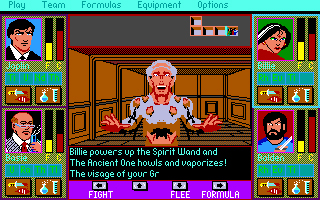 ard
person to be around as he had the Steve Ritchie and David Crane attitude that they were surrounded by idiots. Those guys didn't care if you knew they thought you were an idiot, either. They were like the Sheldon Cooper's of the world. But as you might guess, it takes more than a superior attitude and superior skills to make something, and that is why we were such a great team. We also learned how to work together over time and very much complemented each others
strengths and weaknesses.
ard
person to be around as he had the Steve Ritchie and David Crane attitude that they were surrounded by idiots. Those guys didn't care if you knew they thought you were an idiot, either. They were like the Sheldon Cooper's of the world. But as you might guess, it takes more than a superior attitude and superior skills to make something, and that is why we were such a great team. We also learned how to work together over time and very much complemented each others
strengths and weaknesses.
What I do remember is making Don't Go Alone for Accolade, for the PC later. It was never a great game or a huge success, but it was the classic first-person dungeon game we all loved from the pre-Internet days. Lee and I made it while at Sterling Silver Software and we had a relatively inexperienced artist assigned to us from Accolade that did the graphics. I remember thinking the graphics were not scary enough. They were more in a comic book style with primary colors (before the PC could do more than 16 colors).
Q: Are there any other companies you worked for that I'm missing?
Dennis Koble: I worked as an independent game programmer and consultant, under the name Illogical Software, on many projects and with many companies including a number of Japanese game companies (Namco, Capcom, etc).
After that, I joined Mine Shaft Entertainment (and all its variants) as a programmer
(Ed.: MSE was founded in Mar 2003 and existed until 2011. Rich Adam
was the CEO and co-founded the company with Ed Rotberg). This company went through many iterations. It started out as a captive games group working for "I can't remember the company name" doing Nintendo Game Cube ports. We moved on to many other company associations, including a short stint with Backbone Entertainment, a bottom-feeder out of Emeryville, CA.
Next was Innovative Leisure, a company name that always I associated with making bowling shirts....ok, ok I digress a little here.
I also worked before, during and after as a Expert Witness, doing work for Rockstar Inc./Take-Two Interactive (makers of Grand Theft Auto) for their infamous "Hot Coffee Mod" lawsuits, which involved many, many lawsuits brought by individuals and a number of state's Attorney Generals. I also did several other expert witness gigs during that time.
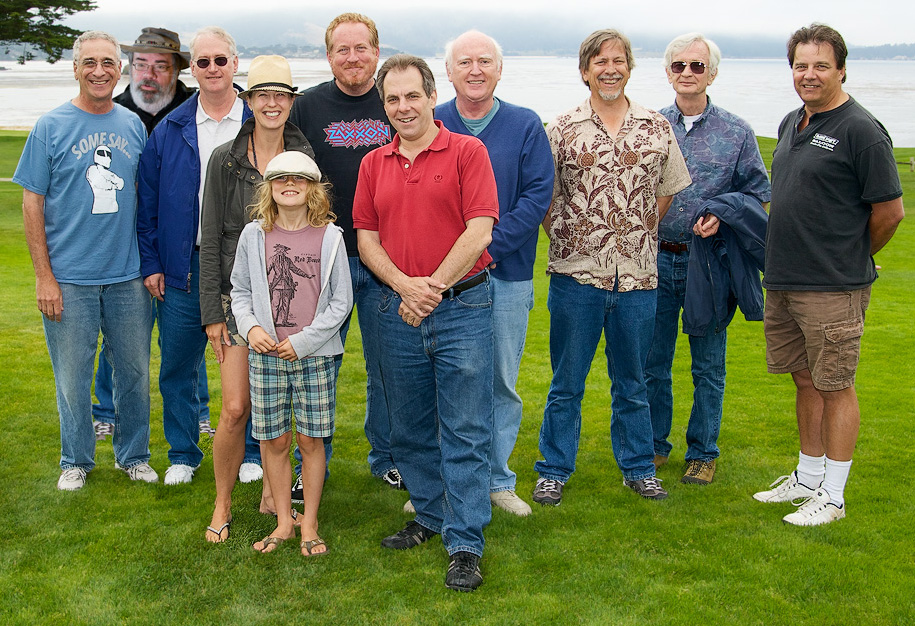
Most of Innovative Leisure at Pebble Beach 2012. From left-to-right: Ed Rotberg, Bruce Merritt, Lyle Rains, Van Burnham,
Seamus Blackley, Owen Rubin, Dennis Koble, Rob Zdybel, Bob Smith, and Rich Adam. Photo courtesy of Dennis Koble.
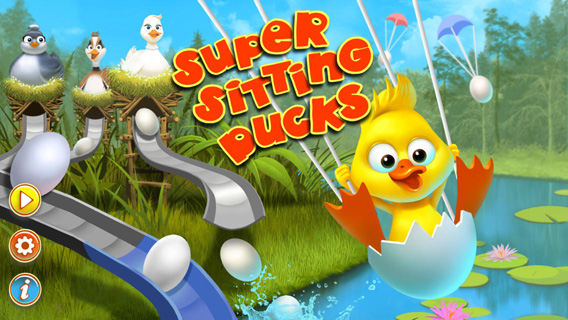
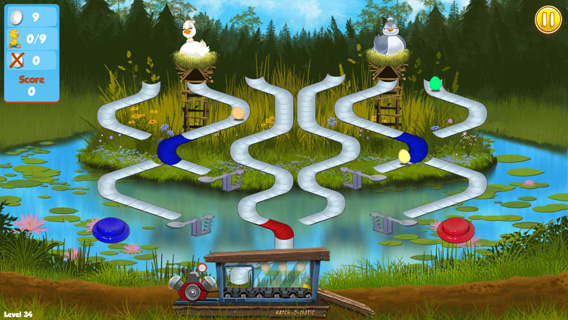
Innovative Leisure's Super Sitting Ducks iOS app.
Q: I wanted to ask you about Innovative Leisure. Back in February of 2012, Seamus Blackley made headlines when he announced this new software design company that he formed, which was mostly comprised of former Atari designers; the plan was to harness their decades of vast game design experience and translate it to a modern gaming platform - Apple's iPad. One article listed what everyone was working on, and you were listed as working on a game called Super Sitting Ducks:
ē Dennis Koble - Super Sitting Ducks
ē Rich Adam - Sonic-like game Echidna
ē Ed Logg - test all new games
ē Lyle Rains - game that will target Angry Birds
ē Bruce Merritt - "perspective twister"
ē Tim Skelly - the "in-house game guru"
ē Owen Rubin - test all new games
ē Ed Rotberg - think of new ways to play games (Rob Zdybel mentioned Ed
worked on a great dragon fighting game)
ē Bob Smith and Rob Zdybel - "reinventing the trackball" for the iPad era
After all the initial fanfare and hyperbole, 6 months later THQ (who agreed to published IL's games)
announced it would not be publishing any mobile games, including those with IL. I never heard anything more about them, or if anything was released, until a recent search revealed your game came out on September 2013 with an updated version (1.21) the following July (app store), and is now free (down from .99c).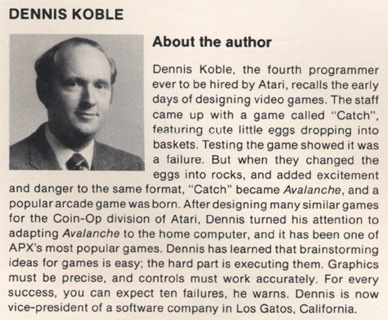
Dennis Koble: Well, that game's release is certainly news to me. Yes, it was a completed game that I did. It was obviously inspired by Chicken Shift, a game done by John Kinsting at Sente. Bob Polaro, another employee that I hired at Atari, did a direct copy of Chicken Shift about a year ago, but I never have played it. I'm happy that Ducks finally made it out there. I was unaware it ever saw the light of day. It's not a great game, but it was never intended to be just the game you see there, as we had big plans for extending it that never happened due to the internal conflicts in the company. The company finally petered out when they ran out of money and all of us went to greener pastures. The ENTIRE company funding was about 2 million dollars and we all made good salaries, but nobody got rich.
Q: The same article from Video Games I mentioned earlier that Imagic was founded with 2 million as well. I thought it was strange to hire people like Ed Logg and have them test new games, but not create any.
Dennis Koble: The difference was, IL turned out to be a very unpleasant experience. What finally happened is that, according to Seamus, he didn't want to ruin his reputation and so the games were never released.
Ed Logg never actually worked at IL, but since he was friend to all of us and his name helped us to get noticed, he was included and given some stock. He ended up attending one or two brain-storming sessions and photo shoots, but that is all.
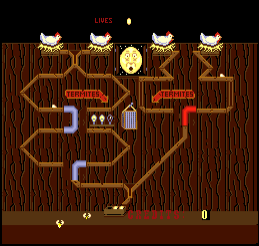
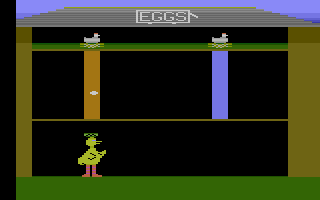
(LEFT) Sente's Chicken Shift; (RIGHT) Atari's VCS Big Bird's Egg Catch.
Q: Chicken Shift always reminded me of VCS Big Bird's Egg Catch, where the player catches eggs rolling down a chute. That game didn't include the sliding puzzle gameplay mechanic from games like Locomotion where you have to complete the path to make something traverse safely from one point to another. From your APX Avalanche manual, that game originally started with the player catching eggs in a basket, so it seems you've come full circle with that motif :)
The same app store also lists Victory Garden being released in December 2015 for .99c.
Dennis Koble: That, Ed Rotberg's Draconus Rex, and Super Sitting Ducks were the only three games done by IL. I don't believe Draconus Rex is available anywhere since it required the maintenance of a dedicated server which the company could no longer afford after awhile. It was done in Unity using Javascript, I believe, and turned into a very fun game with a fairly large user base in the beta and testing phases. My game, however, is a stand-alone 2-D game and works fine on all iOS platforms. It was done using Corona and Lua. Owen Rubin was slated to do Victory Garden but my understanding was that it was never programmed or released, since the Victory Garden game Owen was proposing to program ultimately was very different from what Van Burnham originally proposed/championed. I just asked him about it. From Owen:
| So Super Sitting Ducks was actually released on iTunes as far as I recall. On Victory Garden, that is another story. In order to reserve a game name on iTunes, we uploaded an early version and set a release date in the future, 1 year out. We just assumed we would replace it as time went on. Believe it or not, the game passed the game store tests even in its prototype state, and went live one year later, after IL had closed. I received notification of that because I held the developer license. It went up with a 99 cent price tag. I bought a copy just to have it. I think it was the only one sold! Shortly thereafter, the IL developer account came up for renewal, and Seamus asked me to renew it even though the company was ďclosed". I asked him to pay for it ($99) and he said he would send me the money. Of course, I said I would wait for the money before renewing, and as you can imagine, the account lapsed and I never saw the money. At that time, any games IL had on the store were removed. That included Super Sitting Ducks, Victory Garden, and Draconus Rex. They all came down. This is an interesting link, as when I click on it, I am taken to the iTunes store where I cannot download it. Although the error, "not currently available in the US storeĒ makes me wonder if it is available elsewhere? |
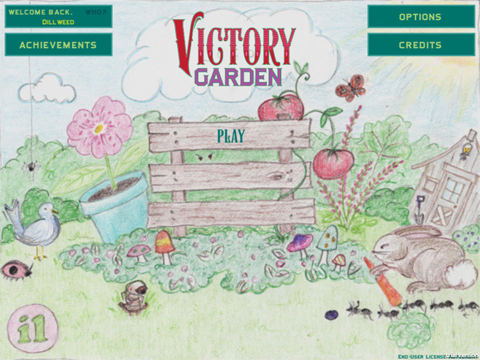 Q: It's a shame nothing more came out of IL (such a waste of all that talent), but I can't say
I'm that surprised to hear it. All I know about Seamus was that he was part of the original XBOX team - the team that designed the system (hardware); he was never a games (software) guy beyond the arcade collection he owns with his wife, Van Burnham.
Q: It's a shame nothing more came out of IL (such a waste of all that talent), but I can't say
I'm that surprised to hear it. All I know about Seamus was that he was part of the original XBOX team - the team that designed the system (hardware); he was never a games (software) guy beyond the arcade collection he owns with his wife, Van Burnham.
Dennis Koble: Van was a major proponent of Victory Garden but was unable to deal with ANY sort of criticism (constructive or otherwise) and was totally unable to take any sort of comments on her proposed idea. She became extremely hostile to ANYONE at IL and refused to respond (email or otherwise) to anyone at the company.
Q: Refusing to respond was something she did years earlier, concerning an Atari VCS game called Escape from Supercade that was to be released in conjunction with her Supercade book. At least 1 cart was made and shown at CGE2K. A high score contest was held in which the winner, David Nelson, was to receive the prototype show copy. and there was also a drawing to give away 25 copies. However, nobody received any, and no carts were ever sold, and all subsequent requests to Van Burnham about it were ignored. She first claimed there was a chip shortage for the reason the game wasn't released (which is impossible considering it's only a 4K game that used a common 2732 EPROM), and years later claimed the company who made the carts, Ebivision, went out of business, which they didn't; according to them, Van Burnham never paid them for programming it, so they renamed it and released it as Power Off! 2 years later. As for the book, she's credited as the author, but she was mainly just the editor; several other well-known writers in the genre, such as Leonard Herman (who wrote the chapter on the Atari VCS/2600) and Steven Kent, contributed to it - all of whom had contracts with Burnham to receive X number of copies, which she apparently broke (according to Herman, they were considering suing her over this at one point). I've seen similar situations with other video game-related 'amateur' projects (pinball games, controllers, system add-on devices, etc). Often it's the result of someone taking on a project far outside their knowledge or experience and getting in way over their head, and taking down those unfortunate enough to commit to them, financially or otherwise. Brian Deuel also noted the book includes information (often verbatim) he helped compile for MAME, which he wasn't credited for (link).
Dennis Koble: Both Seamus and Van Burnham lacked any actual game-making experience, but were convinced they knew how to make games. Although, in the rest of the company's estimation, they didn't. They were both strong personalities, but as you know, many of us in the real games business also have very strong personalities, and it inevitably caused clashes and finally broke up the company. I think that probably contributed to Seamus and Van breaking up, but I really don't know. They divorced right after the company's troubles started to get worse.
What I enjoyed most about IL was the pleasure of working with some of my old compadres from the Atari days - in particular, Lyle Rains, Owen Rubin, Rich Adam, Ed Rotberg, Bob Smith, Rob Zdybel, and Ed Logg. Rob Fulop was never involved, unfortunately.
Q: Are you still working in the industry?
Dennis Koble: No. I do primarily music production these days while Lee became a fairly well-known classical composer. He also conducts orchestras and has a PhD in Music Composition. I have a number of albums that I have produced and created over the years (I think 4 or 5 at last count).
Q: Occasionally, programmers would put little Easter eggs in some of their games that would reveal their name, or a message. Are there Easter eggs in any of your titles? Do you recall any fellow co-workers that did?
Dennis Koble: That came about at the very beginning because Atari did not want the individual programmers to be recognized or accorded any rights for the titles. This became a sore point of contention later and was one of the two reasons that Activision and Imagic came to be. Both of those companies acknowledged the individual contributions to the games on the game and on the box. They also shared more of the proceeds of those games with the creators than Atari was initially willing to do.
Q: What was the easiest/hardest part of designing your games? If you had a chance to redo any of them over, what would you change or what would you have done differently?
Dennis Koble: The games in those early days were primarily technology-driven. Our main goal at Imagic was to try to impress the programmers at Activision (who we admired and respected) with our technical prowess. Also, you have to remember that video games had recently been invented, and we had a rich treasure trove of existing game ideas from other genres including board games, sport games, etc. So the focus wasnít so much on the games as it was on the technology. Once 50 versions of every game type had been made, then the focus turned more over to gameplay (think Electronic Arts).
Q: With your games, were there any features you would have liked to add, or any known bugs or glitches that gave you trouble (or never got resolved)?
Dennis Koble: There were always compromises made in the creation of every game primarily due to technology limitations of the time and hardware. For instance, when I did Trick Shot, there was simply not enough memory (only 128 bytes) nor computing horsepower to use real physics for the ball motions and interactions. Although we did not knowingly produce games with any bugs, there were many known limitations of game play.
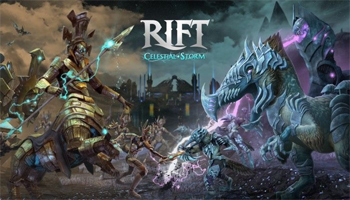 Q: Which of your titles are your favorite, and what types of games in general?
Q: Which of your titles are your favorite, and what types of games in general?
Dennis Koble: I am still an avid game player to this day and probably spend 4 or 5 hours a day playing games. My favorites are not my own of course but rather multiplayer MMOís such as Rift, Everquest 2, and others. Also I am a fan of Doom 2016 and Fallout 4 among many others.
Q: Do you still own any of the games that youíve worked on, either as a keepsake, or to show friends or family?
Dennis Koble: Yes, I have a small treasure trove of games and promotional materials and souvenirs of those days which I keep primarily for myself.
Q: What are your thoughts on how the industry has evolved?
Dennis Koble: Yes, the world changedÖ it's not like the old days of course, and after the games business went through several iterations, it was no longer a business for one or two people to be able to make a competitive game. Lee Actor and myself under the guise of Polygames were probably the last small two-person team to make a go of it in the business mainly due to our reputation and contacts. Even when we were doing Polygames, the groups at the major publishers were already over 100 people.
Today is like a major big deal and not for the Lee Actors or the Dennis Kobles (or any of the old guard, actually) of the world. I suspect many of the companies today employ many hundreds of people to work on a single title ,which takes years to produce. What happened of course was that the graphics became a larger and larger part of each game and so it was necessary to have quite a number of artists to be able to make all the art and animations for a modern game. Also, the "seat-of-the-pants" method that we used in the early days to make games was no longer acceptable when games started costing millions of dollars to develop. The financiers and the accountants took over, it seems. Everything became about the money and return on investment. Iím not bitter about it and I still play quite a number of games on a daily basis, and even though some of us may lament the passing of the beginning, I donít really have that feeling. There are lousy games today and there were lousy games then. There are also great games today as there were then. As with every entertainment product, I felt we were making entertainment for people, not art (there are those who would disagree). We had our time and I have no regrets or recriminations whatsoever. The games business was very good to me and my friends, and I have only good thoughts about being fortunate enough to be in it. As Galadriel narrates in The Lord of the Rings, "Much that once was is lost. For none now live who remember it." LOLÖ.and so it is.
| GAME | SYSTEM | COMPANY | STATUS |
| Dirt Bike! | arcade | Atari | unreleased |
| The Atarians | pinball | Atari | released |
| Sprint 2 | arcade | Atari | released |
| Dominos | arcade | Atari | released |
| Sprint 1 | arcade | Atari | released |
| Catch | arcade | Atari | unreleased |
| Avalanche | arcade | Atari | released |
| Wolf Pack | arcade | Atari | not completed |
| Touch Me | hand-held | Atari | released |
| Pro Ball | hand-held | Atari | unreleased |
| Pro Coach | hand-held | Atari | unreleased |
| Pro Darts | hand-held | Atari | unreleased |
| Tronic 2 | hand-held | Atari | unreleased |
| Avalanche | Atari 400/800 | APX (Atari) | released |
| Sultan's Palace | Atari 400/800 | APX (Atari) | released |
| Chinese Puzzle | Atari 400/800 | APX (Atari) | released |
| Trick Shot | Atari VCS/2600 | Imagic | released |
| Atlantis | Atari VCS/2600 | Imagic | released |
| Solar Storm | Atari VCS/2600 | Imagic | released |
| Shootin' Gallery | Atari VCS/2600 | Imagic | released |
| Stocker | arcade | Bally Sente | released |
| Mini Golf | arcade | Bally Sente | released |
| Night Stocker | arcade | Bally Sente | released |
| Moonquake | arcade | Bally Sente | unreleased |
| Donít Go Alone | PC | Sterling Silver Software (for Accolade) | released |
| PGA Tour Golf | PC, Genesis | Sterling Silver Software (for Electronic Arts) | released |
| PGA Tour Golf: Tournament Course Disk | PC | Sterling Silver Software (for Electronic Arts) | released |
| Hard Drivin' | Genesis | Sterling Silver Software (for Tengen/Atari) | released |
| Pit-Fighter | Genesis | Sterling Silver Software (for Tengen/Atari) | released |
| RoadBlasters | Genesis | Sterling Silver Software (for Tengen/Atari) | released |
| City Golf | Mac, PC | Polygames (for RGA/Philips) | unreleased |
| PGA European Tour Golf | Genesis | Polygames (for Electronic Arts) | released |
| PGA Tour Golf II | Genesis | Polygames (for Electronic Arts) | released |
| PGA Tour Golf III | Genesis | Polygames (for Electronic Arts) | released |
| PGA European Tour Golf | Genesis | Polygames (for Electronic Arts) | released |
| Pit-Fighter II | Genesis | Polygames (for Tengen/Atari) | unreleased |
| Race Drivin' | Genesis | Polygames (for Tengen/Atari) | released |
| Sonic Spinball | Genesis | Polygames (for Sega- Sega Technical Institute designed it) | released |
| Steel Talons | Genesis | Polygames (for Tengen/Atari) | released |
| Xena: Warrior Princess | PS1 | Universal Digital Arts (for Electronic Arts) | released |
| Xena: Warrior Princess 2 | PS1 | Universal Digital Arts (for Electronic Arts) | not completed |
| Super Sitting Ducks | iOS (Apple iPad/iPhone) | Innovative Leisure | released |